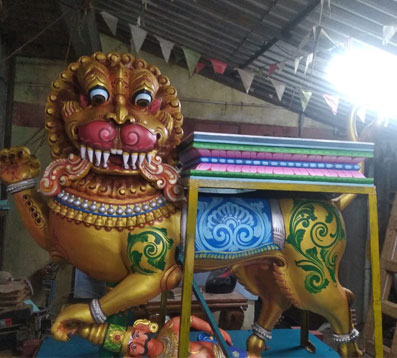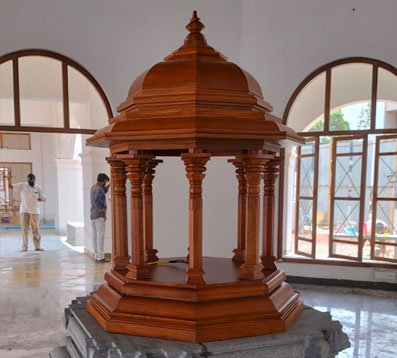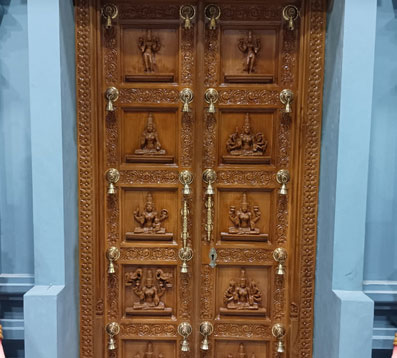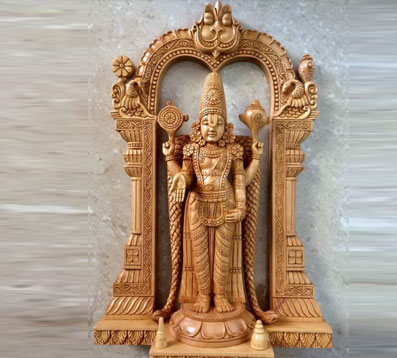

KODI MARAM
We make dhwajsthambam kavacham/ Kodimaram kavcham for temple from copper sheets as per agama shastra.
"Dhwajasthambam" is a term from Sanskrit, where "Dhwaja" means flag or banner, and "sthambam" means pillar. In Hindu temples, a Dhwajasthambam is a tall pillar or flagstaff usually located in front of the main entrance. It often has religious symbols and flags hoisted on top, symbolizing the presence of the divine.

VAGANAM
We provide optimum quality Vahanam Sculpture. Vahana (Sanskrit: Vahana, literally "that which carries, that which pulls") denotes the being, typically an animal or mythical entity, a particular Hindu deity is said to use as a vehicle. In this capacity, the vahana is often called the deity's "mount". Upon the partnership between the deity and his vahana is woven much iconography and mythology. Deities are often depicted riding (or simply mounted upon) the vahana. Other times, the vahana is depicted at the deity's side or symbolically represented as a divine attribute. The vahana may be considered an accoutrement of the deity: though the vahana may act independently, they are still functionally emblematic or even syntagmatic of their "rider". The deity may be seen sitting or standing on the vahana. They may be sitting on a small platform called a howdah, or riding on a saddle or bareback. Vah in Sanskrit means to carry or to transport.

RATHAM
Ratha or Rath also means a large, often very large, wheeled cart made of wood, on which the murti of a deity is carried in religious processions, some of which are very important festivals. The Ratha may be pulled by devotees with rope, or pulled by horses or elephants. Rathas are used mostly by the Hindu temples of South India for Rathoutsava (Temple car festival). During the festival, the temple deities are driven through the streets.chariots are the 12 feet to 15 feet of height and its customized by the customer.

MANDAPAM
Keeping in mind the vast necessities of the patrons, we are engaged in providing wide range of Wooden Temple.
Features:
Termite resistance
Rugged design
Excellent durability
Specification:
Use: Decoration and worshiping
Material: Wooden
Size: As per client’s need

DOORS
Temple doors are mainly made of wood from various natural sources such as Teak. These doors come in different materials and specifications depending upon the requirements of clients. The raw material where these doors come from is sourced from some of the world's best and most durable trees. The strength makes temple doors cost-effective and efficient with heat radiation from the temple. You can find temple doors in various finishes, designs, thicknesses, sizes, and patterns depending on the client's needs. Most temple doors are experienced designers who can engross delicate patterns in wood with flawlessness. The quality of these doors stays intact, even after prolonged and consistent use. These teak doors are sturdy, hard, and thick, and complex as the client wants. Because of the variation in the market, you can also find rose and jack wood to be beneficial for your temple doors. Each find engraving you see on these doors is masterful handicraft of skillful artists.

IDOL
Wooden temple idols are religious or spiritual sculptures made from wood and are commonly used for worship in various cultures around the world. These idols often depict deities, gods, goddesses, or revered figures depending on the religious tradition. The choice of wood, the style of carving, and the symbolic elements incorporated into the idols can vary widely based on the specific religious and cultural context.
Wooden idols are crafted from different types of wood, depending on availability and cultural preferences. Common woods used include sandalwood, teak, neem, mango, and cedar.It's important to note that the significance and practices related to wooden temple idols can vary widely between different cultures and religious beliefs. Whether used in personal home shrines or larger temples, these idols play a central role in the religious and cultural practices of many communities.
